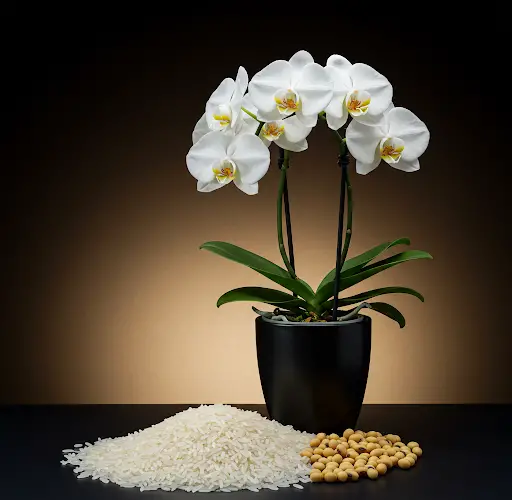A New Way to Help Flower Branches Revive and Bloom Again
Many people think that once an orchid’s flowers have faded, the plant has completed its blooming cycle. However, with the right care and techniques, you can encourage your orchid to continue blooming from the same branches. In this guide, I will introduce an effective and natural method to help orchid branches rejuvenate and bloom again. If you find this information helpful, please support me by subscribing to the channel, liking, and sharing so that more people can learn about this useful orchid-growing tip.
Step 1: Preparing the Orchid After Flowers Fade
Once the flowers on the orchid have faded, don’t discard the branches just yet! These branches can still produce new blooms if properly cared for. The first step is to cut off all the wilted flowers. Then, inspect the plant carefully and remove any diseased leaves to prevent the spread of infection. Additionally, check the roots and trim off any that appear damaged or rotting.
After pruning, sprinkle cinnamon powder on all the cut surfaces. Cinnamon is a natural antifungal and antibacterial agent that helps the wounds dry quickly while preventing infections from developing. Once you’ve applied the cinnamon powder, leave the plant for one full day without watering. This allows the cuts to heal properly before proceeding to the next steps.
Step 2: Preparing a Natural Fertilizer Using Rice and Soybeans
A strong and healthy orchid requires proper nutrition. One of the best natural fertilizers for orchids is a simple homemade solution made from rice and soybeans. Both ingredients provide essential nutrients that promote root growth, leaf development, and continued blooming.
To prepare this fertilizer:
- Take 2 liters of water.
- Add 1 tablespoon of rice.
- Take 3 teaspoons of soybeans.
- Pour in 1 liter of boiled water.
- Let the mixture sit and cool for about an hour before using.
After one hour, strain the mixture to separate the water from the rice and soybeans. This nutrient-rich water will be used to nourish the orchids.
Step 3: Applying the Rice and Soybean Fertilizer
Once the rice and soybean water is ready, follow these steps to apply it to your orchids:
Watering the Orchid Roots
Use this solution to water the orchid roots once a week. Rice water contains essential nutrients such as potassium, phosphorus, and various minerals that strengthen the plant and improve its resilience. Meanwhile, soybeans are rich in nitrogen, which is a crucial element for plant growth, particularly during the stages of blooming and leaf development. The combination of these two ingredients helps to sustain healthy root growth and overall plant vigor.
Planting Soybeans in the Orchid Pot
Take the leftover soybeans and sprinkle 10–20 seeds into each pot. Bury them deep under the tree roots. As the soybeans decompose, they release nitrogen into the soil, further enriching the orchid’s growing environment.
Spraying the Leaves and Branches
In addition to watering the roots, pour some of the nutrient-rich water into a spray bottle. Use this solution to spray the top and bottom of the leaves once a week. The proteins and amino acids found in soybeans help plants grow stronger by enhancing nutrient absorption through the leaves. Spraying the solution on the branches also stimulates bud growth, encouraging the orchid to produce new flower buds.
Step 4: Observing Growth and Continued Care
After consistently following this care routine, significant changes will start to appear.
One Month Later
The old orchid branches will begin growing new shoots. This is a sign that the plant is absorbing nutrients effectively and is ready to produce more flowers.
At this stage, continue the same process:
- Water the orchid roots with rice water once a week.
- Spray the orchid leaves and branches with rice water weekly to supply additional nutrients and stimulate bud growth.
After Another Month
The flower buds will have developed further, preparing the plant for another blooming cycle. Orchids that follow this feeding schedule tend to grow healthier, develop stronger root systems, and bloom for extended periods compared to those that receive standard care.
Why This Method Works
The combination of rice water and soybeans provides a well-balanced nutrient supply for orchids. Here’s why each ingredient is beneficial:
- Rice Water: Contains essential minerals such as potassium and phosphorus, which promote flower and root development.
- Soybeans: Rich in nitrogen, protein, and amino acids that stimulate overall plant growth and improve blooming capacity.
- Cinnamon Powder: Prevents fungal infections and accelerates healing after pruning.
These natural elements work together to create an environment that supports continuous orchid blooming while keeping the plant strong and disease-resistant.
Final Thoughts: Caring for Orchids with Love and Patience
Caring for orchids is a rewarding process that requires patience and dedication. By using this method, you can extend the life of your orchid branches and encourage them to bloom multiple times. Regular feeding, proper pruning, and careful observation will ensure your orchids remain vibrant and healthy.
If you find this guide helpful, don’t forget to share it with fellow orchid enthusiasts. Your support helps spread knowledge about effective and sustainable orchid care methods. Happy growing!



